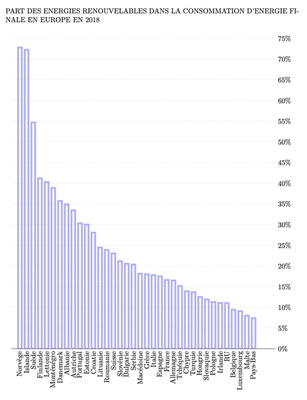Is Switzerland doing well in terms of the use of renewable energies?
Compared to other industrialised countries, Switzerland is in a good position when it comes to all renewable energies. But it is badly placed if only new renewable energies are considered.
The proportion of renewables in Switzerland’s energy mix was about 22% in 2017. It is therefore one of the industrialised countries with the highest share of renewables, which puts it on a par with Lithuania, but still far behind the leaders: the Nordic countries, with Sweden exceeding 50% and Finland 40% by 2017. In terms of electricity production alone, thanks to the large share of hydropower (55%), Switzerland ranks among the leaders, along with Iceland (100%), Norway (98%), Sweden (58%) and Finland (44%) [→ see figure below].
On the other hand, with regard to new renewable energies [→ Q46], Switzerland is far less well-positioned in international comparisons. Electricity is a particularly striking example. In 2018, only 6.1% of Switzerland’s electricity was still generated from renewable sources other than hydropower, although this proportion is increasing year by year: 0.2% from wind power, 3.1% for solar photovoltaics, 2% of the renewable share of waste and 0.9% of biomass derivatives. With this 6.1%, it finds itself at the tail end of industrialised countries, since in 2012 the European average for the proportion of new renewable energies was 12%.
The exploitation of the heat naturally present in the environment is the exception that confirms the rule. With more than 300,000 heat pumps in operation on its territory in 2018, Switzerland has been a pioneer in the use of this technology since the 1960s (along with Sweden, Germany, Austria and the USA). However, the contribution of heat pumps to our energy mix remains below 3% (6.5 TWh).
Overall, Switzerland gives the impression of having rested somewhat on the laurels of hydropower. It has made only a belated and timid start on the development of new renewable energies. Today, the rate of adoption of these energies remains low by international comparison, with the exception of solar energy, which is within the European average and is expected to grow significantly in the coming years. The large number of appeals filed against wind and small-scale hydropower projects continues to hamper the development of these energies.

References
- Groupement professionnel suisse pour les pompes à chaleur (2019)
- Groupement professionnel suisse pour les pompes à chaleur (2019). La pompe à chaleur. [Online]. Available at: www.fws.ch/fr/category/la-pac/.
- International Energy Agency (IEA) (2019)
- International Energy Agency (IEA) (2019). Renewables information: overview.
- Kemmler, A and Koziel, S and Wüthrich, P and Notter, B and Keller, M and Jakob, M and Catenazzi, G (2017)
- Kemmler, A and Koziel, S and Wüthrich, P and Notter, B and Keller, M and Jakob, M and Catenazzi, G (2017). Analyse des schweizerischen Energieverbrauchs 2000-2016 nach Verwendungszwecken. Office fédéral de l'énergie (OFEN).
- Office fédéral de l'énergie (OFEN) (2019)
- Office fédéral de l'énergie (OFEN) (2019). Statistique globale de l’énergie 2018. OFEN.